Content [show]
When okra is called the main star of the modern vegetable garden, exaggeration is out of the question. This plant is one of the most exotic and attractive edible crops. Amazing pods with pronounced edges when cut allow you to get very original "stars", and they themselves will become an adornment of any dish. The fresh taste, reminiscent of eggplants, young peas and asparagus, the unpretentiousness and beauty of the plant itself in the beds deserve much closer attention. Moreover, it is easy to grow okra even where conditions are far from southern.
Getting to know an amazing African woman
A representative of the mallow okra family, known in her homeland in Africa as gombo or okra, and in our country it is often referred to simply as "ladies' fingers" - one of the most fashionable annual lianas. This is a summer plant with straight stems that give a few lateral branches with a height of 30 cm to 2 m.Among the okras there are real vines and bushy plants, but due to the lengthened vegetative period of the climbers in the middle lane, you can hardly find them.
In regions with harsh winters, okras are usually limited to a height typical of bush beans - about 50-60 cm, but create more lush and open bushes. Lobe-separate, large, even-colored leaves form a very elegant crown, emphasizing the beauty of purple stems and creamy flowers with spirally arranged petals and cherry throat, which open in the axils.
Okra, or Okra, or Gombo, or Ladies' fingers (Abelmoschus esculentus)
But the greatest value of okra is not the beauty of the plant itself, but its fruits. Polyspermous capsules, faceted, similar in shape to elongated haircuts of pepper, hide dark, round seeds. Thanks to the edges, the pods themselves are very beautiful, and when chopped, the slices flaunt a star-shaped, very elegant shape.
The length of the pods reaches 25 cm, the maximum diameter is limited to 3 cm (but in order to reach this, the fruits must be fully ripe). Okra bears fruit until the end of September. It is believed that the number of leaves in okra is equal to the number of fruits that this plant can produce with good care.
Okra pods and seeds are very rich in proteins and vitamins, they have a beneficial effect on the functioning of the gastrointestinal tract. This unique vegetable tastes similar to asparagus, and to many resembles a hybrid of green peas and eggplant. And they use it accordingly. This vegetable crop is perfect both for canning and for various first and second courses, salads, for thickening sauces, decorating a meal. Okra looks very nice on plates, and dried and frozen seeds will replenish legumes.
The best varieties for the middle lane
Despite the fact that okra is still an exotic plant in our country, today you can find many varieties of this crop on the market. Almost all of them belong to bushy okras and are perfectly adapted to the conditions of the middle zone with its not too long and hot summer.
Favorite varieties for regions with severe winters include: "White Velvet", "Green Velvet", "Tall 100", "Ladies Fingers", "Dwarf Green", "White Cylindrical 127".
Okra fruits green and red
We select growing conditions for okra
Okra belongs to the most light and heat-loving plants. When choosing lighting, keep in mind that this African culture is used to the bright southern sun. It must be planted in south-facing areas, in the sunniest and warmest areas of the garden and in beds located in the middle of the garden or on its southern side. It is worth paying attention to the fact that the okra should not be bothered by cold winds and drafts.
When choosing growing conditions for this African woman, special attention should be paid to the soil. Indeed, the harvest depends on its fertility. For okra, you should choose soils with a high organic matter content. It is advisable to improve the soil on the site at least a month before planting, and it is better in the fall of the previous year to improve the soil on the site by introducing organic and mineral fertilizers into it in the form of complete mineral mixtures, compost and humus. Okras are not very fond of very dry soil, as well as high humidity, as well as loose and uncultivated soils. For them, it is necessary to choose really high-quality garden soil, loose, permeable and deeply dug up.
Planting okra
Okra in regions with severe winters can be grown:
- through seedlings;
- sowing directly into open soil.
Sowing into soil
Okra is sown together with all melons, along with watermelons and melons. Sowing can be carried out only at the end of May and June, when the soil at a depth of 3-4 cm warms up to more than 15 degrees. It can be used as a compaction crop for cucumbers or planted in separate beds with row spacing of 60 to 70 cm.
General view of the Okra plant
Okra, even in open soil, must be sown deep enough, 3-5 cm. This plant is distinguished by an extended germination period, sometimes it is necessary to wait for emergence of seedlings for more than 3 weeks. To speed up this process and improve germination immediately, when sowing, you need to take care of watering, and then repeat the procedure for moistening the soil after 1-1.5 weeks. As soon as the okras grow up, they are thinned out to a distance of 30 cm between the plants.
Sowing seedlings
In order to increase the yield period, do not wait for the arrival of June for sowing in open soil and, accordingly, get the first harvest earlier, it is best to grow this plant in seedlings. Okra does not like transplanting very much, it develops a strong tap root system, which is easily injured, therefore it is preferable to use peat pots for this culture.
In early May, okra seeds are sown in individual pots, 2-3 seeds each (of which one of the strongest plants is then left). Deepen large grains into the soil by 3-4 cm. Before planting, it is best to soak the seeds for 12-24 hours to accelerate germination. Plants are grown without diving until the very transfer to the beds.
Seedlings are planted in open ground or greenhouses at the age of 45 days. Transplantation into open soil can be carried out for regions with severe winters only after June 10, to the south - after the threat of late spring frosts disappears. The distance between seedlings should be about 30-50 cm, and between rows - from 60 to 90 cm.
Okra care secrets
The status of an exotic plant should not be intimidating: okra does not at all belong to capricious and demanding crops. In terms of the general specifics of cultivation and the care that she needs, this African woman can be equated with beans.
Enhanced care for okras will only be required during the first month of cultivation.... At this time, you will have to remember about constant weeding, maintain stable soil conditions. In the future, caring for the okra is surprisingly simple.
From the first month of growing okra until harvesting from the garden, do not allow the formation of a hard crust on the soil and the active development of weeds. It is necessary to ensure thorough and timely loosening of the soil, which must be carried out regularly, after 10-15 days, supplementing it with weeding... Weeds should not be allowed to develop in the beds, removing them already at a young age. During the summer for adult okra, at least 2-3 weeding is necessary. All of these procedures can be simplified by mulching the soil around the bushes.
Irrigation is the most time consuming component of care throughout the entire period of okra cultivation, but they also should not be systemic. Okras need watering only during a period of prolonged drought, when plants can sharply reduce the number of fruits formed due to complete and prolonged drying out of the soil.... Watering the okra should be deep. The soil must be soaked to a depth of about 30-40 cm.
Okra, or Okra, or Gombo, or Ladies' fingers
As for fertilizing, when planting in fertile soil, plants will not need them at all. If you want to harvest a larger amount of the crop or did not carry out the pre-planting "dressing" of the land, then give the okra two top dressing:
- at the stage of releasing the first buds, apply a complete mineral fertilizer (nitrophoska) for this culture;
- about a month after the start of fruiting, feed the okra with phosphorus-potassium fertilizers (superphosphate and potassium sulfate).
As soon as the okra grows up to 40 cm, it is advisable to pinch the main shoot to increase tillering. As the lateral branches are released, the plant can be tied to supports, but usually a garter is needed only in windy places where the bushes do not retain their shape well.
How and when to harvest
The main trump card of okra is the ability to bear fruit quickly enough. The varieties of this vegetable crop suitable for growing in regions with severe winters are usually early ripening and already 2 months after germination they begin to bear numerous fruits.
In order to enjoy the taste of this exotic, but surprisingly versatile vegetable crop, which is very close to legumes in taste and cultivation characteristics, you need to carefully monitor the age of the fruits. The thing is that okra pods not only grow quickly, but also overripe amazingly quickly. They literally become tough and inedible in one extra day. For eating, the okra fruits must be collected every other day or every day, removing the ovaries from the bush at the age of 3 to 5 days. Do not rush to discard overripe pods. Leave them to ripen the seeds for next year, and remove some of them and extract the hidden seeds from them. They can be used as legumes or roasted and made into a gombo coffee drink.
Care must be taken when harvesting okra. This culture often causes skin irritation due to the specific pubescence of the pods. It is best to remove the fruits with gloves, so that contact of the plant with unprotected skin areas is impossible.
Be careful: the harvested crop is stored for an extremely short time. Even in the refrigerator, okra pods quickly become fibrous and tough. They retain their taste and texture only for 1-2 days, so the harvested fruits must be eaten immediately, boiled, frozen, canned or dried.
 Okra is a plant of interest to exotic lovers. How to grow a vine from seeds, how to plant it on the site, how to care for it - everything is described in the article. Photos will help you get to know more about the overseas culture.
Okra is a plant of interest to exotic lovers. How to grow a vine from seeds, how to plant it on the site, how to care for it - everything is described in the article. Photos will help you get to know more about the overseas culture.
Description of the plant and its variety
The plant has several names: okra, edible albemosh, gombo, ladies' fingers. Botanists attribute it to the Malvov family and the Albemos genus. Okra can be described as follows:
- Annual. The height of its stem depends on the variety.Dwarf varieties grow only up to half a meter, and tall ones can reach 2 m.
- Large leaves, covered with a fringe, are held by long petioles. Complex, divided into 5 or 7 blades.
- The stalk is strong, covered with tough, sometimes prickly, hairs. At the base, it branches into several shoots.
- The flowers of the okra are single, large, cream-colored. They resemble a gramophone in shape.
- The multi-seeded fruit is represented by a long box (up to 25 cm). It looks like a pepper pod.
- The skin can be either smooth or fleecy, depending on the variety.
The homeland of okra is Africa. Here, its unripe fruits have long been eaten. The rest of the plant is used by the locals to make cloth and use it to make glue.
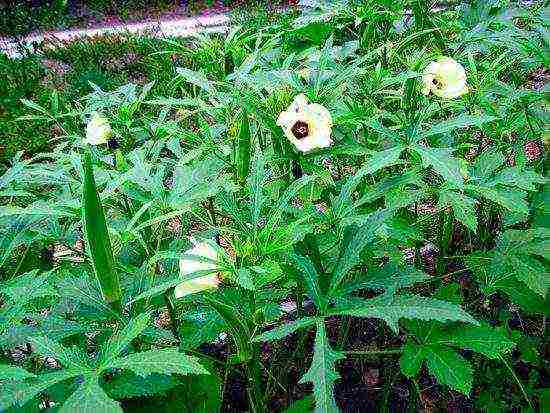
Okra blossom
The fruit tastes like a cross between zucchini and asparagus beans. The high content of nutrients makes them attractive to supporters of a healthy diet.
Attention! Torn boxes cannot be stored for a long time. They become fibrous, rough.
Crop consumption is steadily increasing and breeders are constantly working on replenishing varieties. Among gardeners, the following are in demand:
- Star of David - it can be called the most popular variety. The short (7 cm) thick fruit has a star-shaped cross-section. Refers to tall okra. Differs in leaves of an unusual purple color.
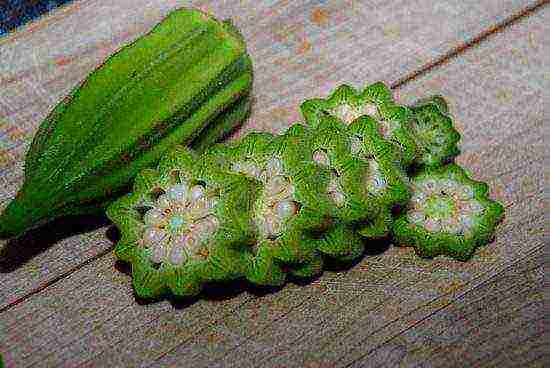
Star of David variety
- Blondie is one of the early ripening varieties. The pods are about 8 cm long. Painted yellow-green.
- Cow horn - the stem grows up to 2.5 m. The fruits of the variety are quite long (up to 25 cm), tasty, endowed with a strong aroma.
- Alabama Red - also refers to tall. Differs in dark red pods. Can be used as an ornamental plant.
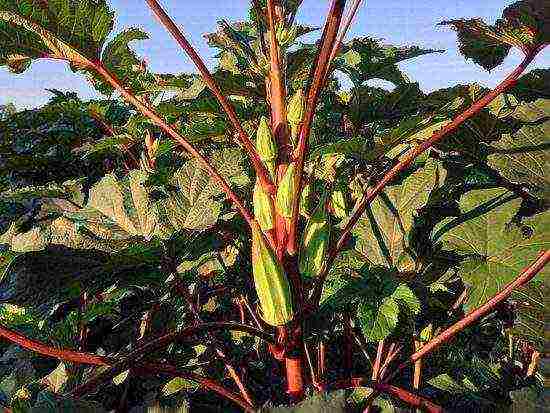
Alabama Red variety
- Clemson Spineless - the fruits of the variety are not pubescent. The color of the pods is dark green, their average length is 15 cm.The stem reaches 1.5 m.
The listed varieties have perfectly adapted to the climate of the middle zone, but in cool areas it is better to cultivate them in greenhouses.
Growing seedlings
Okra is a thermophilic plant, so in the middle lane it is better to grow it through seedlings. They do it like this:
- The day before sowing, the seeds are soaked in a damp cloth.
- The substrate is prepared from garden soil, peat and river sand (2: 2: 1). Fill them into small containers.
Advice. Okra reacts very badly to transplanting, so it is better to sow seedlings in peat pots.
- One seed is planted in each pot, deepening it by 1.5 cm.
- The plantings are well watered.
- All pots are installed in one large container and a greenhouse is built around them from polyethylene.
- Place crops in a warm place.
Seedlings appear in three weeks, after which the film is removed and the pots are rearranged on a light windowsill. Seedling care is reduced to regular watering and feeding with fertilizer for seedlings. A couple of weeks before the planned planting in the ground, the seedlings should be hardened by exposing them to fresh air every day.
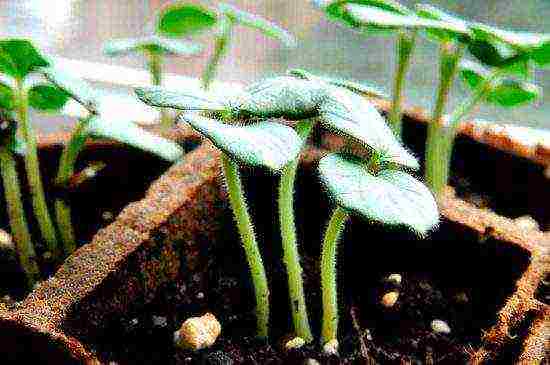
Okra shoots
How to plant and care for okra in a garden
The okra bed is prepared in the fall. For this, the planned site is well loosened with the simultaneous introduction of manure and superphosphate into the soil. In the spring (before planting), nitrogen-containing fertilizers are additionally applied.
The holes are dug at a distance of 50 cm from each other. They should be the same size as the pot. One plant is planted in each, sprinkled with soil and watered. For tall varieties, supports are immediately installed. Top of the planting is mulched with compost.
Advice. In case of a severe cold snap in the garden, it is advisable to install arcs. So you can quickly cover the plantings.
Okra care consists of the following works:
- glaze;
- plant formation;
- loosening the soil;
- dressing.
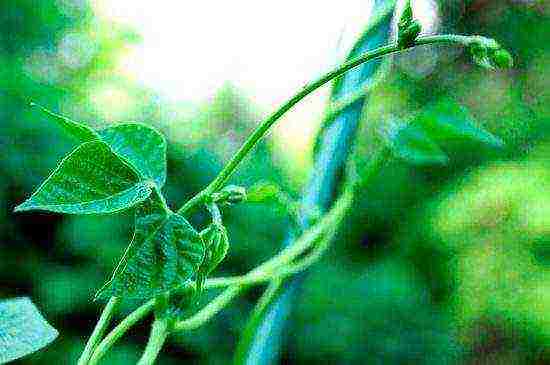
If the soil is fertile, you do not need to feed additional okra
The plant does not require frequent watering. It is enough to moisten the soil as it dries.It should be borne in mind that when waterlogged, the okra roots quickly rot and the plant may die. The formation is carried out when the seedlings reach a height of 50 cm. At this time, the top of the main stem is pinched off. Reception causes the active appearance of lateral shoots, which, accordingly, increases the number of ovaries.
Loosening of the soil is carried out regularly, not allowing a crust to form. The plant can be hilled. This will keep moisture in place longer.
It is not necessary to feed the okra. If the soil is fertile and the bed is well prepared, then the plant will receive enough nutrients.
How to harvest, what diseases can you face
Okra blooms 2 months after planting. On the fifth day after opening the buds, you can start harvesting. The boxes should not be allowed to overripe, they become rough, it is impossible to eat them. In the middle lane, it is recommended to harvest fruits every 3 days. In areas to the south, this should be done daily.
Advice. Okra seeds can be roasted and consumed as a coffee substitute.
During the period of prolonged rains, the plant can be "attacked" by powdery mildew fungi. Since the fruits are collected almost continuously, it is extremely undesirable to fight the disease with chemicals. To prevent the disease, prophylactic spraying with infusions of herbs, onion husks, and garlic is recommended.

Inspect okra regularly for pests
The stalks and leaves of okra are affected by a rust fungus, which is manifested by the appearance of red pads on them. In case of minor damage, it is necessary to remove the diseased parts of the plant and destroy them. Of the pests on okra, you can find aphids, spider mites, slugs. It is also better not to use chemistry to destroy and scare them away.
Okra is still a little-known culture in the middle lane. However, thanks to the excellent taste and the efforts of gardeners, the fruits of this heat-loving plant are increasingly appearing on the tables of residents of cool regions.
Growing okra: video
Okra - a plant of the malvaceae family. This vegetable is also called gombo, okra and ladies' fingers. The fruits have 5-7 faces, inside which there is a large number of small seeds (see photo). They reach an average length of 25 cm. The surface of the okra is covered with fluff, which must be removed before use so that it does not cause any allergic reaction when consumed. The fruits are colored bright green. The taste of this plant is somewhat similar to asparagus and eggplant.
The homeland of these fruits has not yet been established. This can be West Africa or India, since in this area you can find a large number of cultivated and wild plants of this type.
Since okra contains a lot of mucus, to get rid of it, you need to add something sour while cooking, such as vinegar or tomatoes.
Unfortunately, okra fruits are not popular in our area.
Okra varieties
There are several varieties of okra that are most in demand on the territory of Russia, which differ from each other in the shape and size of the fruit:
- Ladies' fingers, or, alternatively, okra, are grown to produce edible seed pods. Such a plant reaches about one meter in length. After planting and before the first harvest, it should take about a hundred days. The stem of the "Ladies fingers" variety is completely covered with sparse hairs. Visually, the fruit of the plant resembles a capsicum with hairs. To get rid of unwanted hairs, it is enough to wipe the fruit with a hard cloth. The fruits are hidden in the leaf axils. It is noteworthy that this variety is resistant to hot conditions and drought. This plant can be harvested twice a year if the climate is warm. The fruits of this type of okra are best consumed while still unripe, since they contain a sticky substance that is used to thicken dishes. Also, the plant is put in vegetable salads, soups and side dishes. It can be dried, canned, or frozen. Variety "Ladies fingers" is perfect for people who adhere to dietary nutrition, as well as for patients with atherosclerosis.
- The oak grove is undersized. The height of its stem is about eighty centimeters. In the lower part of the stem, the leaves are five-lobed, and at the top they are dissected. Flowers are yellow and medium in size (diameter - nine centimeters). As soon as the fruit is ripe, it takes on a dark green color. Its length varies from eighteen to twenty centimeters. If such a variety of okra is grown for planting future seeds, then up to eight fruits can form on the plant, and each will contain about fifty seeds.
- The oak grove is mid-season. Once the plants are planted, it will take about sixty-five days to collect the first collection of ovaries. The seeds ripen within one hundred and twenty days. This type of okra bears fruit for about thirty days. During this period, the crop can be harvested seven or nine times. Variety "Mid-season Dubrava" should be planted only in open ground. The ovaries themselves can be consumed by people who adhere to a diet.
- The pipe is medium-sized. The stem height varies from one hundred and fifteen to one hundred and twenty centimeters. The inflorescences are yellow in color and relatively small (about seven centimeters). The fruit itself is green and reaches a length of about twenty centimeters. If the plant is grown for planting seeds, then about ten fruits on the okra can grow, and the seeds inside the fruit will be olive green.
The pipe is mid-season. Once the plants are planted, it will take about sixty-eight days to collect the first collection of ovaries. The seeds ripen within one hundred and twenty-five days. This type of okra bears fruit for about thirty-four days. During this period, the crop can be harvested up to nine times.
Beneficial features
Numerous beneficial properties of okra are possible due to its rich vitamin and mineral composition. So, the high content of folic acid makes okra a product that is recommended for pregnant women. Such a source of vitamin B9 is much more useful than synthetic vitamins.
Okra contains plant mucus - dietary fibers that have the ability to regulate blood sugar levels, which means that the consumption of such a product is shown to people suffering from diabetes. Okra also has the ability to reabsorb water, remove excess cholesterol, toxins and bile from the body.
Okra has substances that improve the functioning of the digestive tract. Eating this vegetable regularly prevents constipation and bloating and has the ability to heal stomach ulcers... Okra has the ability to increase the growth of beneficial bacteria in the small intestine called probiotics.
This vegetable can be used during diets, as it belongs to low-calorie foods. The fruits contain substances that strengthen the walls of blood vessels, and therefore the vegetable can be used in dietary nutrition for atherosclerosis.
A huge amount of nutrients makes it possible to use okra not only for improving the body, but also for cosmetic purposes. Masks are made from boiled vegetables that improve the condition of the hair, make it stronger and shinier. The okra extract in the cream will help clear acne from the skin as well as help get rid of uneven skin.
The fruits help improve health during sore throats, depression and chronic fatigue.

Cooking use
Okra can be used in cooking, but it can be cooked in completely different ways, for example, it can be salted, marinated, fried, stewed, steamed and deep-fried. Besides, fruits can be eaten raw.
This vegetable can easily replace zucchini in ratatouille and stews.
Okra can be used to prepare a variety of side dishes, and can also be added to salads and soups.These fruits are perfectly combined with Provencal oil and various spices, which allows you to improve the taste of a dish made on the basis of an exotic vegetable.

Okra can be dried and frozen to be able to use the fruit all year round.
In addition to pods, young leaves can also be used for food. They are added to salads and soups. Seeds are also good food. They are fried and used to make a bitter-tasting beverage that is somewhat similar to coffee. In addition, okra seeds are used to make oil with a specific taste and smell. And also, young seeds of this vegetable can replace green peas.
How to cook?
To understand how to cook okra, you must first understand some of its features.
The exotic vegetable resembles a green pepper in its appearance, only with villi on the outside and seeds on the inside. When buying such a fruit in a store, you should not choose its large size. It is better that its length does not exceed ten centimeters, otherwise you risk buying an old and overripe fruit.
Before cooking, wash the okra thoroughly, wipe it with a hard cloth to remove hairs, cut off the stem.
In order to prevent the pods from darkening, you should not use cast-iron dishes for cooking, and in order to prevent the okra from spreading during the cooking process, you should not stir it with a spoon and subject it to a long heat treatment.
When preparing sauces or soups, the mucus secreted by this exotic vegetable can be an important asset. It will give the required viscosity to the prepared dish. If the appearance of viscosity in the dish is undesirable, the okra should be fried or, thinly sliced, cook until the mucus completely evaporates.
How to preserve?
There are several ways to preserve okra. It can be closed in jars either separately or combined with other vegetables.
You must remember the main thing - okra should be young and, preferably, recently plucked from the garden. Do not preserve a vegetable if it has been in the refrigerator for several days.
If the okra is cut across in small pieces, it will look very beautiful in a jar, like little stars. You can also preserve it whole: you only need to cut off the tip of the stem.
Before you start canning okra, you need to prepare the vegetable or vegetables if you decide to combine okra with anything else. First of all, wash all the ingredients well, prepare the spices and marinade, which should simmer over low heat before distributing it into the jars. Sterilize the jars, put all the ingredients in them, cover with boiling marinade and drain into a saucepan. Repeat this procedure several times. At the very end - pour the prepared marinade over the cut and put in jars of okra and close hermetically with sterilized lids.
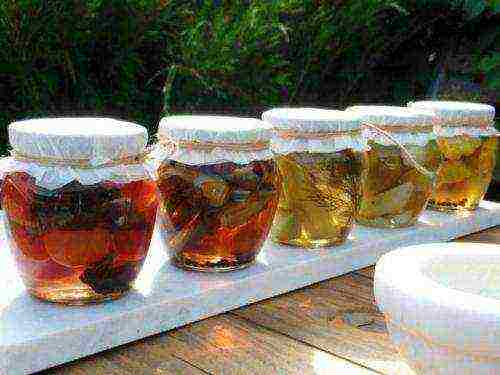
Okra benefits and treatment
The benefits of okra have been proven after a series of experiments that have confirmed that fruits can prevent the development of various types of cancer, and they also reduce the risk of developing cataracts and diabetes... In addition, due to its rich composition, many doctors recommend these fruits to patients who have recently undergone surgery.
It has been proven that the vegetable is able to cope with many of the problems that cause impotence.
In folk medicine, okra is used to treat many diseases associated with the respiratory and digestive systems. Basically, decoctions are prepared from it and infusions are made.
|
Disease |
Method of treatment |
|
Atherosclerosis |
For the treatment of this disease, alternative medicine experts recommend eating about two hundred grams of okra per week. |
|
Cold and severe cough |
For the treatment of the upper respiratory tract, you need to take two tablespoons of ground okra roots and pour them with three glasses of water (you need warm and boiled water). The infusion should stand for about one hour, then strain it and add a little honey there (for sweetness).Take the infusion one tablespoon about eight times a day until the disease disappears completely. |
Also, the use of okra in its pure form or dishes with the addition of this vegetable is useful for people suffering from diabetes mellitus, with diarrhea, constipation. In addition, okra helps to increase male potency.
Below is a video about an amazing plant - okra.

Okra harm and contraindications
Okra can be harmful if you are hypersensitive to the product. This product has no more contraindications.
Growing: planting and care
 Okra is a thermophilic plant and should not be grown outdoors unless you are in the southern region. This plant needs a certain soil and conditions for its maturation.
Okra is a thermophilic plant and should not be grown outdoors unless you are in the southern region. This plant needs a certain soil and conditions for its maturation.
The soil should be fertile and fertilized. Fertilize it for okra in the fall. While digging, add humus, compost and superphosphate to the soil.
First, you need to grow seedlings by planting okra seeds immediately in separate containers, since this plant does not like transplants, around the beginning of May. In order for them to quickly rise and grow into good seedlings, you need to soak the seeds in water for a day and observe the temperature regime throughout the entire growing period. The room temperature should be 20-25 degrees.
To plant okra in a greenhouse or greenhouse, they begin after about 45 days, at a distance of 30-60 cm from each other and 50-90 cm - for tall varieties.
Caring for the plant is as follows: it is necessary to regularly water the okra with water, weed the weeds and huddle the bushes, and also feed it. Fertilize the plant before flowering with mineral fertilizers, and when the fruits appear, use potassium nitrate.
This plant has many names: okra, okra, gombo, ladies' fingers or edible abelmos - this is how it is called because it belongs to the genus Abelmos of the Malvov family. Originally from tropical Africa, in the Middle Ages it was brought to Europe and was able to take root and spread in southern Europe. In Russia, it is considered exotic, they learned about okra recently, when it appeared on store shelves. Nevertheless, we grow their own okra, in small volumes, in the southern regions - in the Krasnodar Territory and in the Stavropol Territory. Local okra is more valuable: its unique beneficial qualities are best manifested when freshly picked fruits are consumed, without preservatives.
What does okra look like and why is it valuable
The vegetable culture okra is an annual herb. She has a thick pubescent stem, branched at the base, long-petiolized large leaves, in the axils of which there are large creamy flowers. Fruits are multi-seeded capsules.
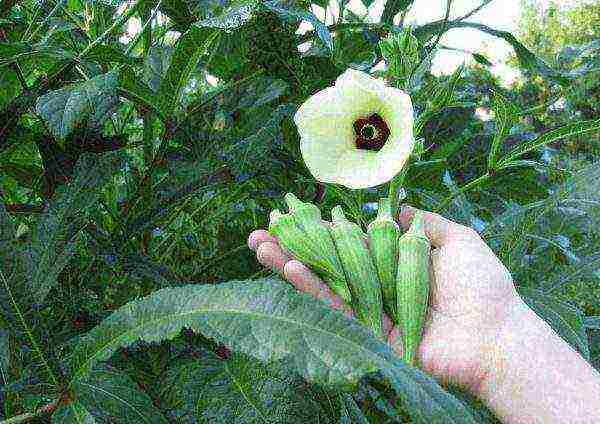
Okra flowers are quite decorative, but its main value is in the fruits.
All varieties bloom with rare single cream flowers, shaped like tulips, with a strong tart odor. The plant is quite decorative, but the main value is in the fruits. Okra fruits are shaped like green pepper pods. They are sometimes described as "a cross between bean pods and pepper."

Okra fruit tastes like asparagus
The whole plant is covered with dense pubescence, which can cause allergies and itchy skin, therefore, it is necessary to collect the fruits with gloves, and remove the hairs before preparing the fruits.
The world is unanimous in recognizing the benefits of this vegetable. Okra is recommended for medical nutrition with a huge list of diseases, because the main effect of its use is to increase the general tone of the body, strengthen immunity and supply the body with a complex of vitamins and minerals. The plant has a unique composition, which provides its benefits.
- Vitamins A, B6, C, K increase immunity, so okra recovers well in case of overwork and after illness.
- Minerals magnesium, iron, calcium, potassium, sodium, zinc, phosphorus are involved in the processes of blood circulation, strengthening blood vessels and normalizing blood pressure.
- Due to the large amount of fiber, normal bowel function is maintained.
- Vegetable proteins give a feeling of fullness with a minimum calorie content, and this normalizes weight.
- Mucous substances normalize sugar levels in diabetes, have an anti-inflammatory effect on the gastrointestinal tract.
- Folic acid is beneficial for pregnant women for the proper development of the fetal neural tube.
- The antioxidant glutathione prevents the development of cancer.
Okra is booming in the United States now: it is considered the number one natural remedy for cancer prevention.

Okra is considered an aphrodisiac, although there is no serious scientific research on this topic.
Main varieties
Depending on the height of the plants, the following varieties are distinguished:
- undersized - bushes 40-50 cm high;
- medium-sized - up to 70 cm;
- tall - up to 2 m.
In the state register of selection achievements, among those admitted to cultivation on the territory of Russia, there are varieties Juno, Bombay, Vlada.
- Juno. This is a tall variety, up to 2 m, so it is quite productive - 1.7–2.5 kg per square meter. m. Fruits are large, multifaceted, from 10 to 25 cm long, grow very quickly. They are eaten 4-7 days after the ovary is set and as long as they retain their green color. Overripe fruits become tough and lose their taste. It is grown from seeds in seedlings. Recommended to grow indoors.
- Bombay. Low-growing mid-season variety. The period from full germination to the beginning of the economic shelf life is 75 days when grown in the open field. The height of the plant in technical ripeness is 60 cm. The rosette of leaves is raised. Stem and leaves are green, flowers are light yellow. 9-10 fruits (ovaries) about 9 cm long are formed on one plant.
- Vlada. The variety is mid-season, undersized - plant height 40–65 cm. Green stem with sparse hard pubescence. The rosette of leaves is raised, the leaves are dark green in color, the flowers are yellow-cream. One plant forms 18–20 fruits (ovaries) 18–20 cm long.
However, our traveling gardeners bring foreign varieties and try to grow them in their beds.
- Lady fingers. Mid-ripening (period from germination to the beginning of the economic shelf life of 90–115 days) variety for growing in open ground and film greenhouses. Plant up to 1 m high. Fruits in the form of green faceted finger-shaped pods, 6 to 20 cm long.
- White velvet, Green velvet (differ in fruit shades.). Height 30–40 cm. Fruiting is abundant and long-lasting - almost until the frost.
- Red velvet. Late grade. Aesthetically valuable: the fruit is red rather than green in color.
- Star of David. Tall variety, short fruits - up to 8 cm.
In any case, if you grow okra in cold regions, you should choose varieties with the shortest growing season of 60 days. They will have time to give a crop in the shortest period of heat.
Photo gallery: okra varieties
How to grow okra in our conditions
The tropical origin of this plant can force many gardeners in Ukraine, the Moscow region, central Russia and even more so Siberia to abandon even attempts to grow this plant at home. But there is literary evidence that the writer A.P. Chekhov more than a century ago successfully cultivated okra in his Melikhovo near Moscow. In the open ground, okra ripens only in the south, in central Russia it can be planted only in greenhouses, and in Siberia it is generally recommended to grow it on a window in a house.
In order to grow okra with us, you need to understand well what this plant needs.
Priming
In the tropics, 1 sq. m, a huge amount of mass grows, which rotates on the spot for centuries, forming a very loose and fertile layer of soil of great thickness. This is the native soil for okra.
Our soils, even fertile loose chernozems, will require improvement with a large amount of loose humus. Or peat, but peat contains almost no nutrients, so it, in turn, must be corrected by adding a complex fertilizer according to one of the universal recipes:
- 30 g of nitrogen fertilizer, urea urea or ammonium nitrate, and 0.5 liters of wood ash per 10 liters of peat;
- 40 g complex fertilizer;
- 20 g of nitrogen fertilizer, 20 g of nitroammophoska.
It is important to know that the main thing for okra is warmth, not the quality of the soil. In a cold summer, it will not grow even on the best soil. And vice versa - in a warm summer it will grow even on imperfect soil.
Illumination
Okra does not have an extra demand for light. By definition, the tropics are thickening, shading and fighting for a place in the sun. But in our northern latitudes, it should grow exclusively in a sunny place no closer than 6 m from buildings and high thickets on the south side and no closer than 4 m from other sides, for fences and low shrubs these figures are 4 and 2 m, respectively.
Planting scheme for low-growing varieties - 30–40 cm between bushes, 60 cm between rows. For medium-sized people, these figures are 10 cm more, and for tall ones they are another 10 cm more.

It is very important for okra in our latitudes to grow in a well-lit area.
Temperature conditions
It is important that the normal development of okra does not literally require tropical heat and humidity. At all stages, from germination to the end of the growing season, it grows quite normally at temperatures of 20-30 degrees. But if recently planted tomatoes, peppers, cucumbers and other thermophilic crops can easily withstand cold snaps up to 15 degrees, and short-term even up to 5 degrees, then for planted okra seedlings everything below 20 degrees is a stop in development, and below 10 degrees - harm , as for other crops, from frost. But an adult strong plant by the end of summer can already tolerate cold snaps, even up to frost.
Despite its tropical origin, okra does not like excessive heat above 40 degrees. This should be taken into account when growing indoors, where at the peak of summer without ventilation, the temperature on a sunny day often rises above this mark.
Growing seedlings from seeds
Okra is an annual plant with a relatively short growing season, only 3-4 months. Therefore, despite the thermophilicity and late dates of planting in open ground, it does not need to be planted as early in February as pepper. The seeds are planted in the ground on March 10–20, and the colder the climate, the later the planting, until the beginning of April. There is no point in planting too late, the okra will not have time to yield. The seeds are soaked in warm water for a day. They are planted deep enough, 2-3 cm. The first shoots should appear in 10-14 days.
The seedling soil may be slightly poorer, poorer in composition and heavier in structure than in the open field at a permanent planting site. Once in better soil, all plants can more easily tolerate the stress of transplanting.
Transfer to the garden
Okra is planted in open ground very late, in the middle lane on June 10-15. By this time, the earth warms up to a great depth, accumulates heat in a huge massif, and even a short-term drop in air temperature cannot harm thermophilic crops. Due to the late planting dates, okra seedlings are grown in larger containers than other crops. It is not recommended to plant in common boxes, only in separate dishes.
To have enough for development for the entire period before planting, you need a capacity of at least 1 liter per bush. Moreover, the capacity should be high, because the okra has a long central root. When planting, it is important not to damage the taproot.
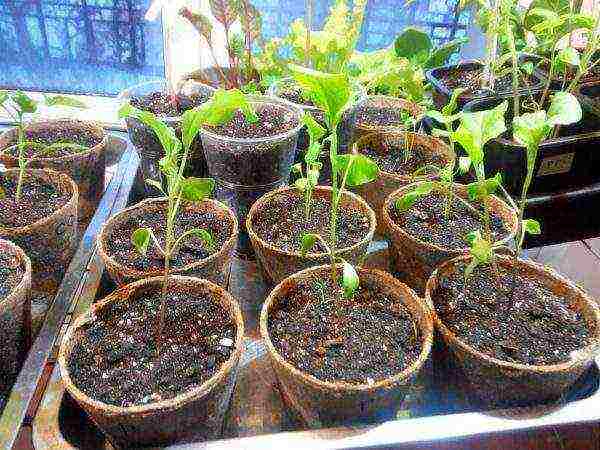
Okra is recommended to be grown in peat pots and planted in the ground in them.
Care
Under a film shelter or in a greenhouse, both day and night temperatures are higher, so okra will grow better indoors. But unlike other crops, it often needs to be ventilated. Excessive moisture can cause gray rot.
When grown on fertile soils, top dressing is not required.In other cases, feeding is required:
- with a weak increase in green mass - with nitrogen fertilizers: watering with a solution of 40 g of urea or ammonium nitrate per 10 liters of water;
- during fruiting - phosphorus fertilizers: nitroammophos or superphosphate, 30 g per 10 liters of water.
The plant is drought-resistant and does not require moisture. On the contrary, in dense, moisture-proof soils, the roots can rot. Therefore, watering is required in dry weather to keep the soil moist for the entire growing period.
Mulching with a layer of up to 10 cm with hay, straw, dry needles, rotten sawdust, humus will greatly facilitate maintenance. Under the mulch, the ground steams, becomes softer and looser, does not dry out, less often requires watering.
Weeds rarely penetrate through a thick layer of mulch, so it is enough to remove all weeds before mulching once a season.
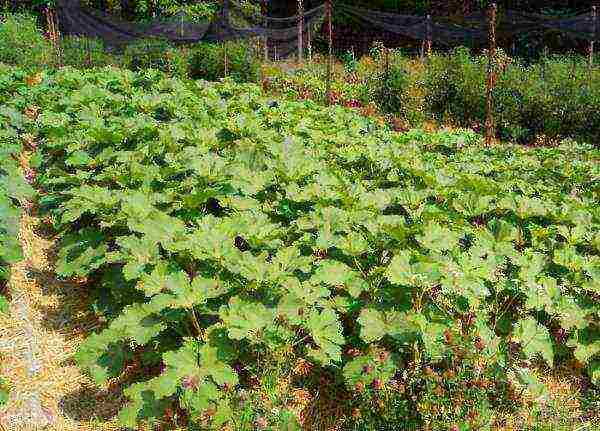
Okra plantations are mulched with straw to protect against weeds
Light mulch reflects sunlight and prevents the earth from warming up. Therefore, light mulch can be spread only on well-heated soil, and dark mulch - at any soil temperature, it will not interfere with solar heating.
In the second half of summer, the central stem must be pinched to stop the growth of the green mass and the formation of a new ovary, which will no longer have time to grow before the cold weather. Then the plant will direct all its forces to growing the already formed ovaries.
The plant can suffer from the same diseases and pests as local crops - powdery mildew, gray rot, thrips, slugs. The measures to combat these misfortunes are the same as for all plants, with the recommended preparations according to the instructions.
Video: growing rules and useful properties of okra
Reviews of gardeners
There is not a lot of practical experience in growing okra in Russia. However, the valuable qualities of this plant make it very interesting for gardeners, and promising for breeders.
Rate the article:
(2 votes, average: 3.5 out of 5)


